Unveiling Structural Secrets: Active Learning for Assessing Ultimate Load Capacity in Parallel Wire Cable Systems under Time-Varying Force Identification with Frequency-Squeezing Processing and Vibration Frequency Method
Abstract
:1. Introduction
2. Methodology
2.1. Generalized Framework
2.2. Cable Force Identification Using FSP-VFM
2.2.1. Vibration Frequency-Based Method
2.2.2. Frequency-Squeezing Processing
2.3. Resistance Deterioration Model of Parallel Wire Cables
2.3.1. Daniel’s Model for the Strength of a Parallel Wire Cable
2.3.2. Strength Deterioration Factor under Coupled Corrosion–Fatigue Influence
2.4. Active Learning Reliability Analysis Based on GP Modeling
3. Reliability Assessment on Gengcun Dou Bridge with SHM Data
3.1. Description of Bridge and Its Monitoring System
3.2. Monitoring Data Analysis and the Probability Model Establishment
3.2.1. Monitoring Data Analysis
3.2.2. Load Effect Modeling
3.3. Reliability Assessment of Stay Cables
4. Conclusions
Author Contributions
Funding
Data Availability Statement
Conflicts of Interest
References
- Yang, L.; Ye, M.; Huang, Y.; Dong, J. Study on Mechanical Properties of Displacement-Amplified Mild Steel Bar Joint Damper. Iran. J. Sci. Technol. Trans. Civ. Eng. 2023, 1–14. [Google Scholar] [CrossRef]
- Luo, Y.; Liu, X.; Chen, F.; Zhang, H.; Xiao, X. Numerical Simulation on Crack–Inclusion Interaction for Rib-to-Deck Welded Joints in Orthotropic Steel Deck. Metals 2023, 13, 1402. [Google Scholar] [CrossRef]
- Luo, Y.; Liao, P.; Pan, R.; Zou, J.; Zhou, X. Effect of Bar Diameter on Bond Performance of Helically Ribbed GFRP Bar to UHPC. J Build. Eng. 2024, 91, 109577. [Google Scholar] [CrossRef]
- Li, H.; Zhang, F.; Jin, Y. Real-Time Identification of Time-Varying Tension in Stay Cables by Monitoring Cable Transversal Acceleration. Struct. Control Health Monit. 2014, 21, 1100–1117. [Google Scholar] [CrossRef]
- Kmet, S.; Tomko, M.; Brda, J. Time-Dependent Analysis of Cable Trusses Part II. Simulation-Based Reliability Assessment. Struct. Eng. Mech. 2011, 38, 171–193. [Google Scholar] [CrossRef]
- Xiong, W.; Xiao, R.; Deng, L.; Cai, C. Methodology of Long-Term Real-Time Condition Assessment for Existing Cable-Stayed Bridges. Adv. Struct. Eng. 2010, 13, 111–125. [Google Scholar] [CrossRef]
- Zheng, Y.; Zhang, Y.; Lin, J. BIM–Based Time-Varying System Reliability Analysis for Buildings and Infrastructures. J. Bridge Eng. 2023, 76, 106958. [Google Scholar] [CrossRef]
- Zhou, Y.; Chen, S. Time-Progressive Dynamic Assessment of Abrupt Cable-Breakage Events on Cable-Stayed Bridges. J. Build. Eng. 2014, 19, 159–171. [Google Scholar] [CrossRef]
- Zhang, J.; Chen, K.J.; Zeng, Y.P.; Yang, Z.Y.; Zheng, S.X.; Jia, H.Y. Seismic Reliability Analysis of Cable-Stayed Bridges Subjected to Spatially Varying Ground Motions. Int. J. Struct. Stab. Dyn. 2021, 21, 2150094. [Google Scholar] [CrossRef]
- Zhou, Y.; Chen, S. Reliability Assessment Framework of the Long-Span Cable-Stayed Bridge and Traffic System Subjected to Cable Breakage Events. J. Bridge Eng. 2017, 22, 04016133. [Google Scholar] [CrossRef]
- Wang, C.; Beer, M.; Ayyub, B.M. Time-Dependent Reliability of Aging Structures: Overview of Assessment Methods. ASCE-ASME J. Risk Uncertain. Eng. Syst. Part A Civ. Eng. 2021, 7, 03121003. [Google Scholar] [CrossRef]
- Li, J.X.; Yi, T.H.; Qu, C.X.; Li, H.N.; Liu, H. Adaptive Identification of Time-Varying Cable Tension Based on Improved Variational Mode Decomposition. J. Bridge Eng. 2022, 27, 04022064. [Google Scholar] [CrossRef]
- Fan, Z.Y.; Huang, Q.; Ren, Y.; Zhu, Z.Y.; Xu, X. A Cointegration Approach for Cable Anomaly Warning Based on Structural Health Monitoring Data: An Application to Cable-Stayed Bridges. Adv. Struct. Eng. 2020, 23, 2789–2802. [Google Scholar] [CrossRef]
- Dan, D.; Zeng, G.; Pan, R.; Yin, P. Block-Wise Recursive Sliding Variational Mode Decomposition Method and Its Application on Online Separating of Bridge Vehicle-Induced Strain Monitoring Signals. Mech. Syst. Signal Process. 2023, 198, 110389. [Google Scholar] [CrossRef]
- Zhang, H.; Aoues, Y.; Lemosse, D.; Bai, H.; De Cursi, E.S. Time-Variant Reliability-Based Optimization with Double-Loop Kriging Surrogates. In Proceedings of the 5th International Symposium on Uncertainty Quantification and Stochastic Modeling: Uncertainties 2020; Springer: Berlin/Heidelberg, Germany, 2021; pp. 436–446. [Google Scholar]
- Afshari, S.S.; Pourtakdoust, S.H. Probability Density Evolution for Time-Varying Reliability Assessment of Wing Structures. Aviation 2018, 22, 45–54. [Google Scholar] [CrossRef]
- Yang, N.; Li, J.; Xu, M.; Wang, S. Real-Time Identification of Time-Varying Cable Force Using an Improved Adaptive Extended Kalman Filter. Sensors 2022, 22, 4212. [Google Scholar] [CrossRef] [PubMed]
- Yu, X.; Dan, D. Real-Time Cable Force Identification Based on Block Recursive Capon Spectral Estimation Method. Measurement 2023, 213, 112664. [Google Scholar] [CrossRef]
- Zhang, H.; Zhou, Y.; Huang, Z.; Shen, R.; Wu, Y. Multiparameter Identification of Bridge Cables Using XGBoost Algorithm. J. Bridge Eng. 2023, 28, 04023016. [Google Scholar] [CrossRef]
- Zhu, W.; Teng, W.; Liu, F.; Wu, D.; Wu, Y. Measurement of Cable Force through a Fiber Bragg Grating-Type Thin Rod Vibration Sensor and Its Application. Sensors 2022, 22, 8081. [Google Scholar] [CrossRef]
- Wu, W.H.; Chen, C.C.; Lin, S.L.; Lai, G. A Real-Time Monitoring System for Cable Tension with Vibration Signals Based on an Automated Algorithm to Sieve out Reliable Modal Frequencies. Struct. Control Health Monit. 2023, 2023, 9343343. [Google Scholar] [CrossRef]
- Shafighfard, T.; Kazemi, F.; Bagherzadeh, F.; Mieloszyk, M.; Yoo, D.Y. Chained Machine Learning Model for Predicting Load Capacity and Ductility of Steel Fiber–Reinforced Concrete Beams. Comput.-Aided Civ. Infrastruct. Eng. 2024. [Google Scholar] [CrossRef]
- Asgarkhani, N.; Kazemi, F.; Jakubczyk-Gałczyńska, A.; Mohebi, B.; Jankowski, R. Seismic Response and Performance Prediction of Steel Buckling-Restrained Braced Frames Using Machine-Learning Methods. Eng. Appl. Artif. Intell. 2024, 128, 107388. [Google Scholar] [CrossRef]
- Zheng, P.; Wang, C.; Zong, Z.; Wang, L. A New Active Learning Method Based on the Learning Function U of the AK-MCS Reliability Analysis Method. Eng. Struct. 2017, 148, 185–194. [Google Scholar]
- She, A.; Wang, L.; Peng, Y.; Li, J. Structural Reliability Analysis Based on Improved Wolf Pack Algorithm AK-SS. Structures 2023, 57, 105289. [Google Scholar] [CrossRef]
- Zhang, C. The Active Rotary Inertia Driver System for Flutter Vibration Control of Bridges and Various Promising Applications. Sci. China Technol. Sci. 2023, 66, 390–405. [Google Scholar] [CrossRef]
- Ehre, M.; Papaioannou, I.; Sudret, B.; Straub, D. Sequential Active Learning of Low-Dimensional Model Representations for Reliability Analysis. SIAM J. Sci. Comput. 2022, 44, B558–B584. [Google Scholar] [CrossRef]
- Marrel, A.; Iooss, B. Probabilistic Surrogate Modeling by Gaussian Process: A Review on Recent Insights in Estimation and Validation. Reliab. Eng. Syst. Saf. 2024, 110094. [Google Scholar] [CrossRef]
- Nannapaneni, S.; Hu, Z.; Mahadevan, S. Uncertainty Quantification in Reliability Estimation with Limit State Surrogates. Struct. Multidiscip. Optim. 2016, 54, 1509–1526. [Google Scholar] [CrossRef]
- Zhang, L.; Qiu, G.; Chen, Z. Structural Health Monitoring Methods of Cables in Cable-Stayed Bridge: A Review. Measurement 2021, 168, 108343. [Google Scholar] [CrossRef]
- Yu, X.; Dan, D. Block-Wise Recursive APES Aided with Frequency-Squeezing Postprocessing and the Application in Online Analysis of Vibration Monitoring Signals. Mech. Syst. Signal Process. 2022, 162, 108063. [Google Scholar] [CrossRef]
- Chen, Y.; Zheng, X.; Luo, Y.; Shen, Y.; Xue, Y.; Fu, W. An Approach for Time Synchronization of Wireless Accelerometer Sensors Using Frequency-Squeezing-Based Operational Modal Analysis. Sensors 2022, 22, 4784. [Google Scholar] [CrossRef]
- Faber, M.H.; Engelund, S.; Rackwitz, R. Aspects of Parallel Wire Cable Reliability. Struct. Saf. 2003, 25, 201–225. [Google Scholar] [CrossRef]
- Mao, J.X.; Wang, H.; Li, J. Fatigue Reliability Assessment of a Long-Span Cable-Stayed Bridge Based on One-Year Monitoring Strain Data. J. Bridge Eng. 2019, 24, 05018015. [Google Scholar] [CrossRef]
- Hou, N.; Sun, L.; Chen, L. Cable Reliability Assessments for Cable-Stayed Bridges Using Identified Tension Forces and Monitored Loads. J. Bridge Eng. 2020, 25, 05020003. [Google Scholar] [CrossRef]
- Rasmussen, C.E.; Williams, C.K.I. Gaussian Processes for Machine Learning. In Adaptive Computation and Machine Learning; MIT Press: Cambridge, MA, USA, 2008; ISBN 978-0-262-18253-9. [Google Scholar]
- Melchers, R.E.; Beck, A.T. Structural Reliability Analysis and Prediction, 3rd ed.; Wiley: Hoboken, NJ, USA, 2018; ISBN 978-1-119-26607-5. [Google Scholar]
- Moustapha, M.; Marelli, S.; Sudret, B. A Generalized Framework for Active Learning Reliability: Survey and Benchmark. arXiv 2021, arXiv:2106.01713. [Google Scholar]
- Moustapha, M.; Marelli, S.; Sudret, B. Active Learning for Structural Reliability: Survey, General Framework and Benchmark. Struct. Saf. 2022, 96, 102174. [Google Scholar] [CrossRef]
- Echard, B.; Gayton, N.; Lemaire, M. AK-MCS: An active learning reliability method combining Kriging and Monte Carlo simulation. Struct. Saf. 2011, 33, 145–154. [Google Scholar] [CrossRef]
- Teixeira, R. Adaptive Approaches in Metamodel-Based Reliability Analysis: A Review. Struct. Saf. 2021, 89, 102019. [Google Scholar] [CrossRef]
- Deng, Y.; Liu, Y.; Chen, S. Long-Term In-Service Monitoring and Performance Assessment of the Main Cables of Long-Span Suspension Bridges. Sensors 2017, 17, 1414. [Google Scholar] [CrossRef] [PubMed]
- Ding, Y.; Ye, X.W.; Guo, Y. Data Set from Wind, Temperature, Humidity and Cable Acceleration Monitoring of the Jiashao Bridge. J. Civ. Struct. Health Monit. 2023, 13, 579–589. [Google Scholar] [CrossRef]
- Li, H.; Li, S.; Ou, J.; Li, H. Reliability Assessment of Cable-Stayed Bridges Based on Structural Health Monitoring Techniques. Struct. Infrastruct. Eng. 2012, 8, 829–845. [Google Scholar] [CrossRef]
- Ren, Y.; Xu, X.; Huang, Q.; Zhao, D.-Y.; Yang, J. Long-Term Condition Evaluation for Stay Cable Systems Using Dead Load–Induced Cable Forces. Adv. Struct. Eng. 2019, 22, 1644–1656. [Google Scholar] [CrossRef]
- Luo, Y.; Fu, W.; Wan, H.P.; Shen, Y. Load-Effect Separation of a Large-Span Prestressed Structure Based on an Enhanced EEMD-ICA Methodology. J. Struct. Eng. 2022, 148, 04021288. [Google Scholar] [CrossRef]
- Li, J.X.; Yi, T.H.; Qu, C.X.; Li, H.N.; Liu, H. Early Warning for Abnormal Cable Forces of Cable-Stayed Bridges Considering Structural Temperature Changes. J. Bridge Eng. 2023, 28, 04022137. [Google Scholar] [CrossRef]
- GB50068; Load Code for the Design of Building Structures. Ministry of Housing and Urban-Rural Development of the People’s Republic of China; China Architecture & Building Press: Beijing, China, 2018.

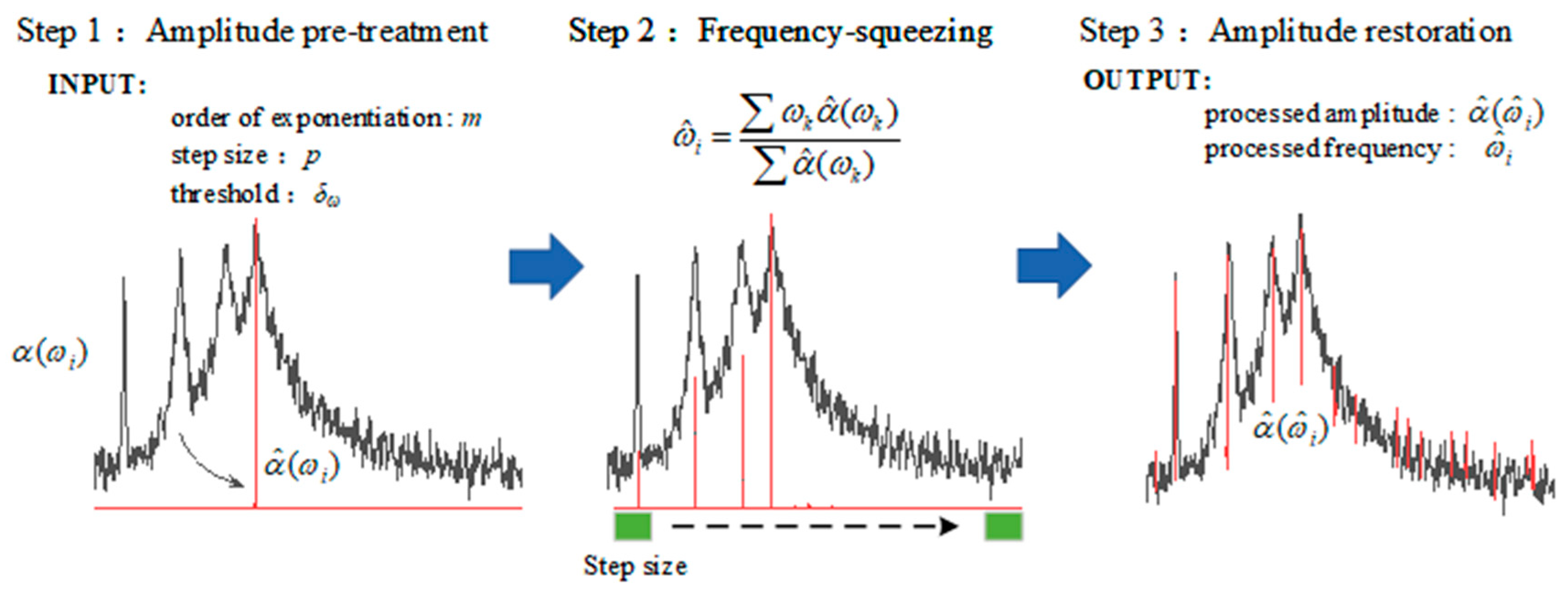
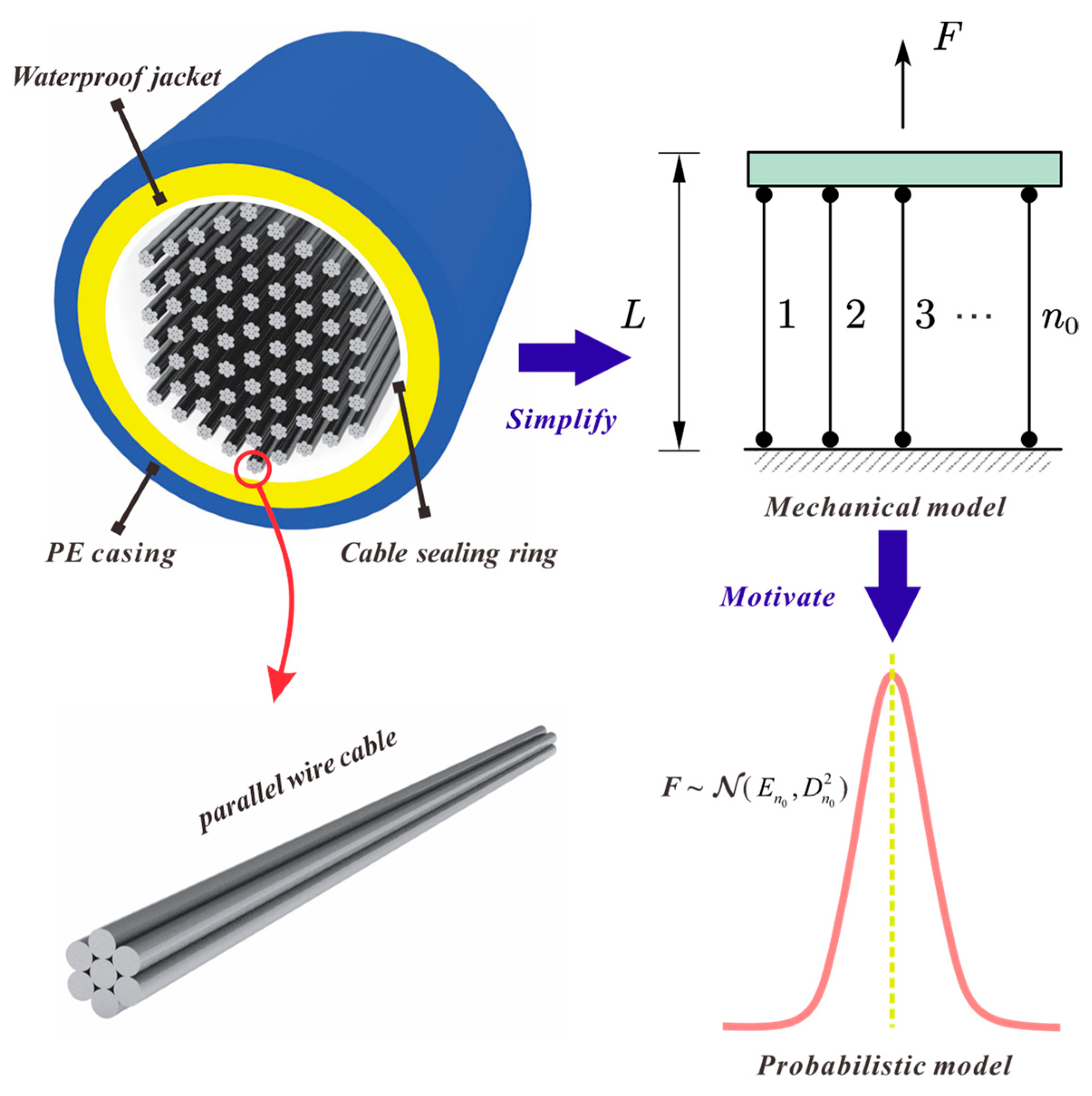
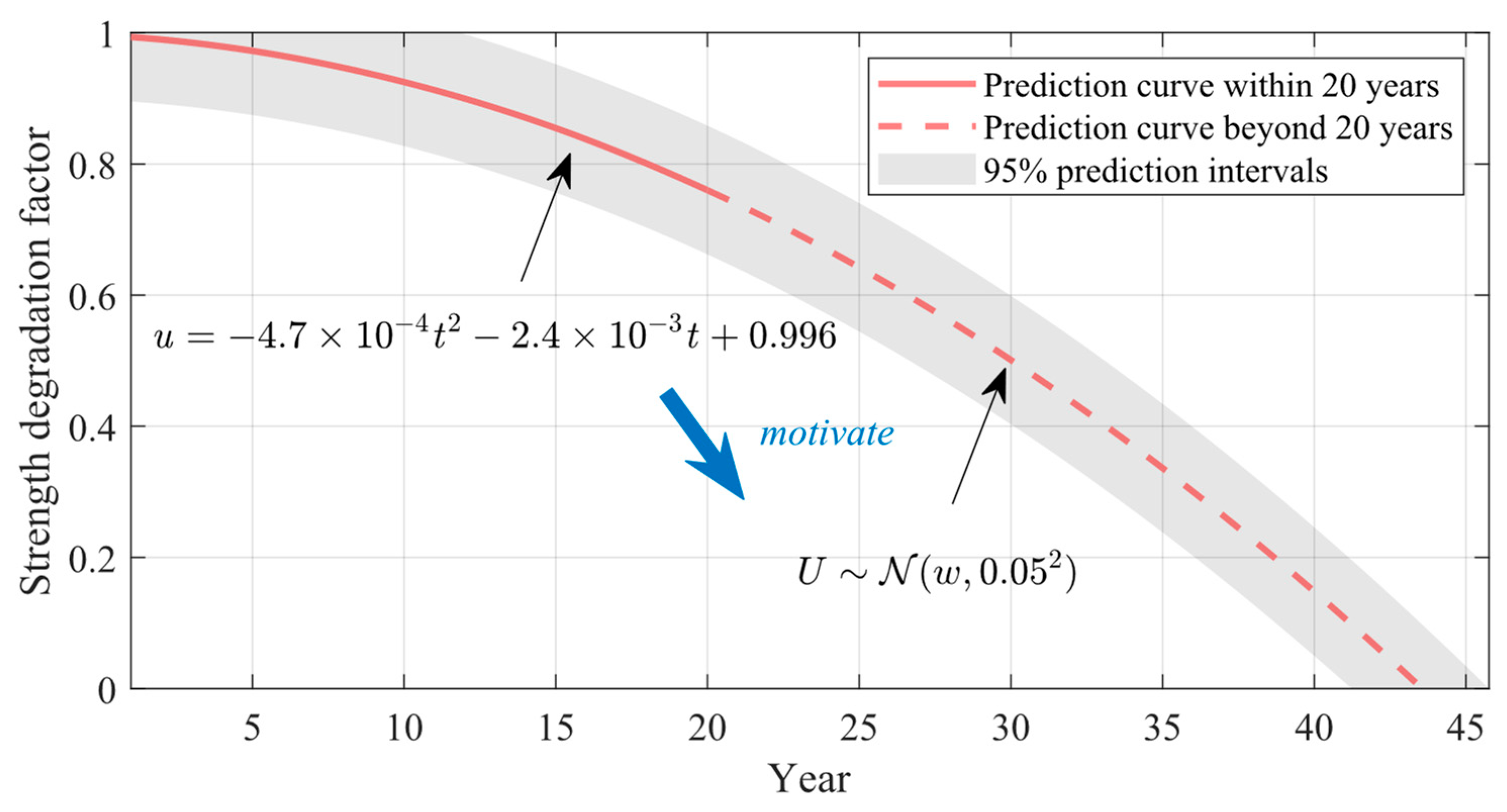

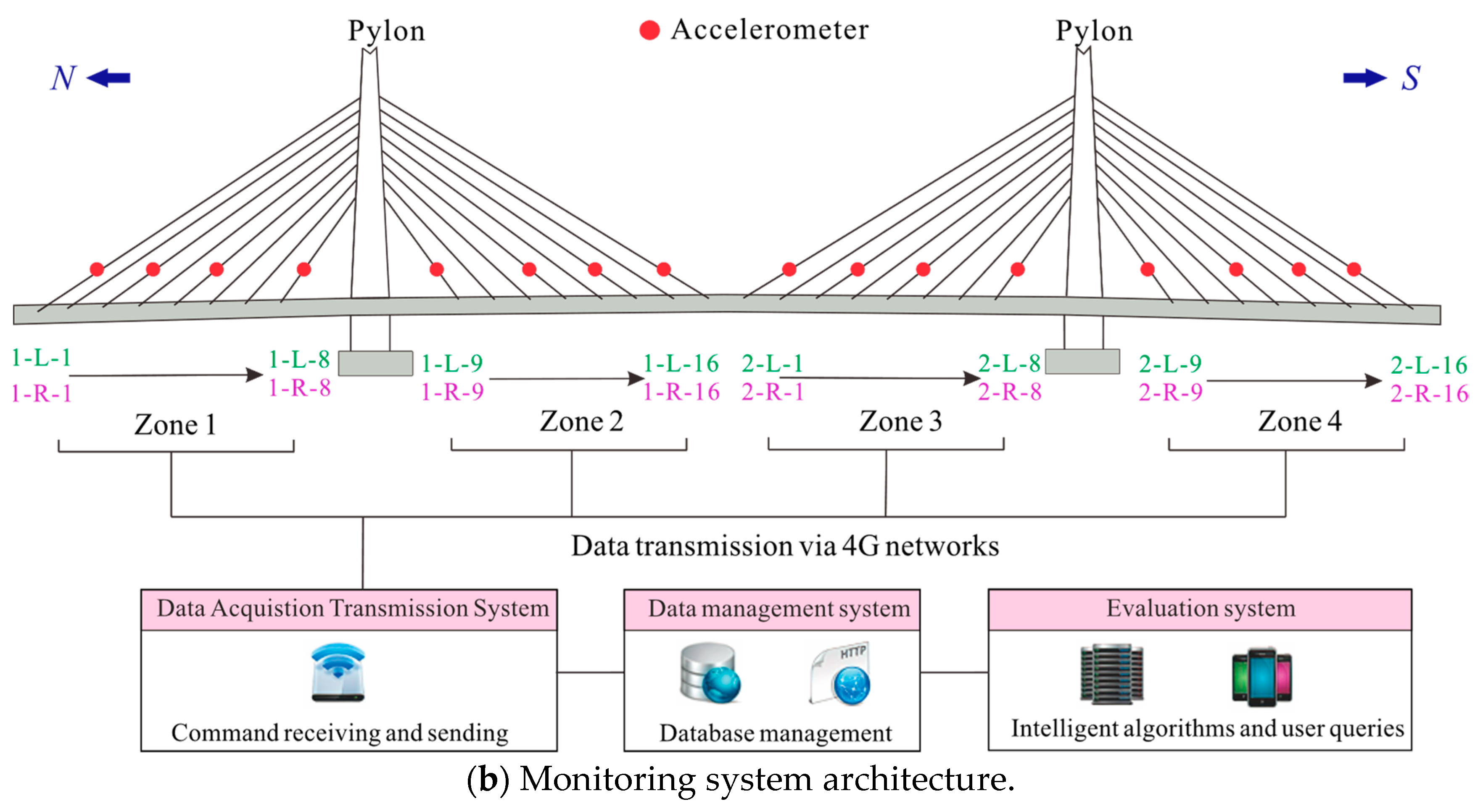
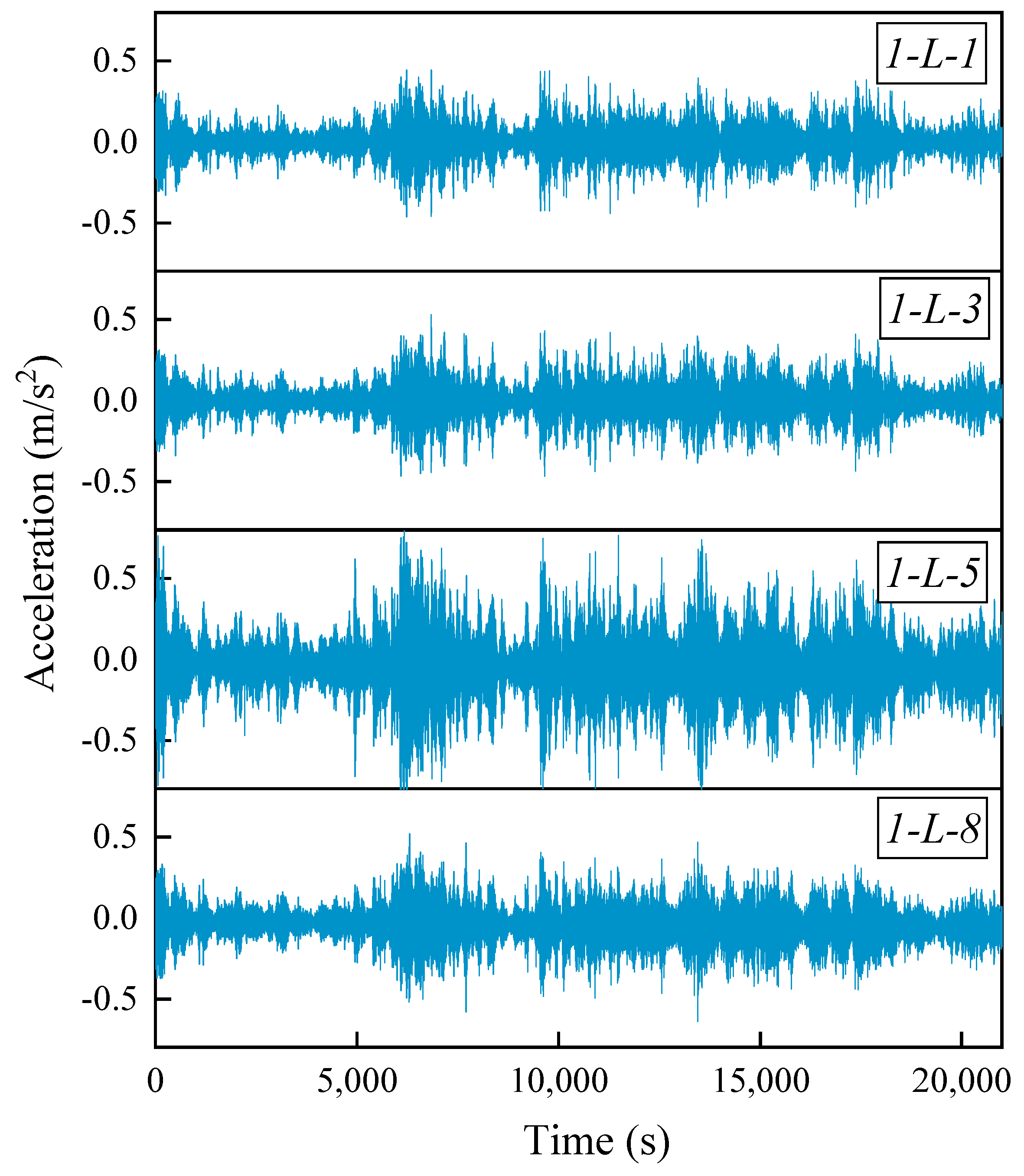




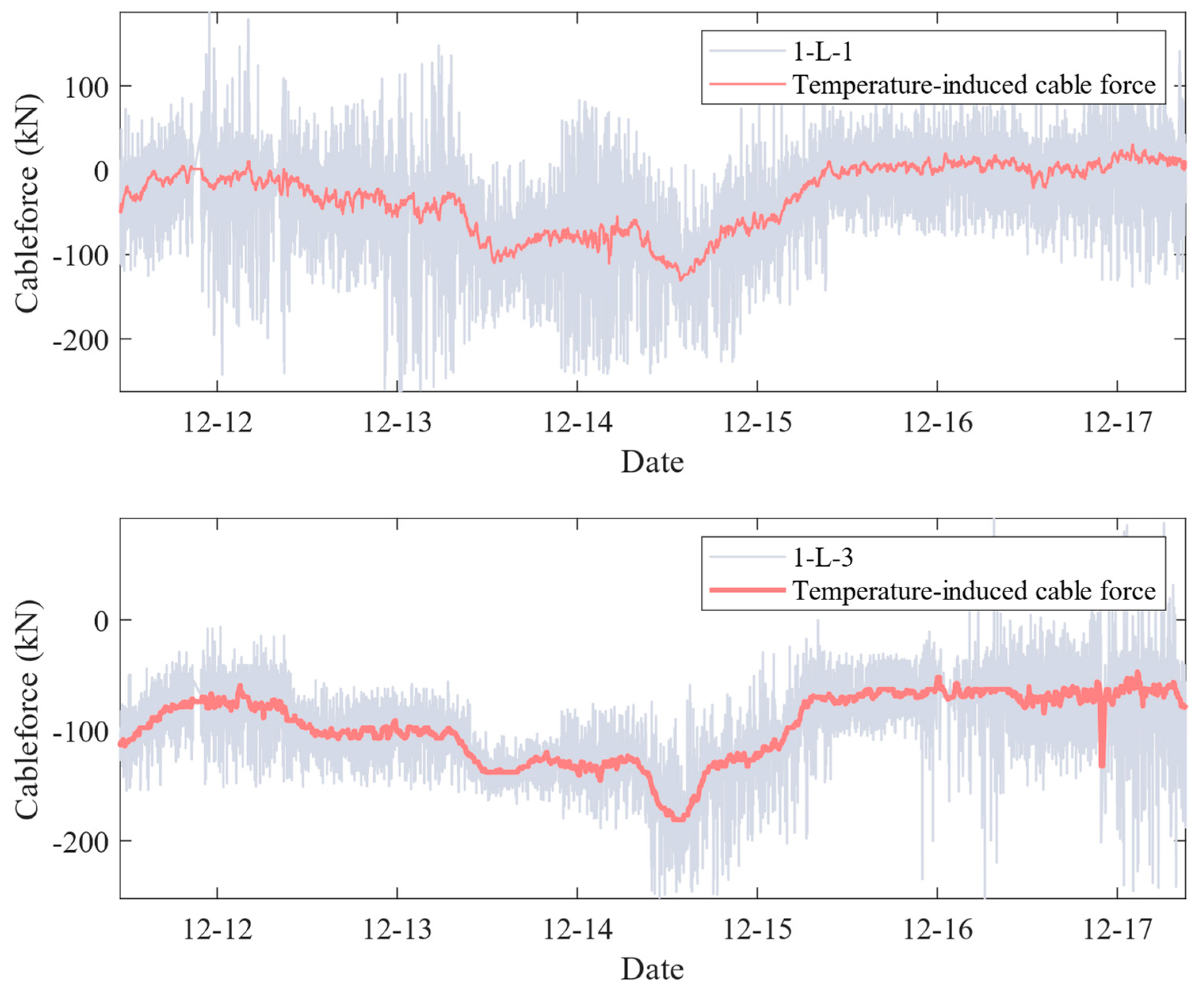
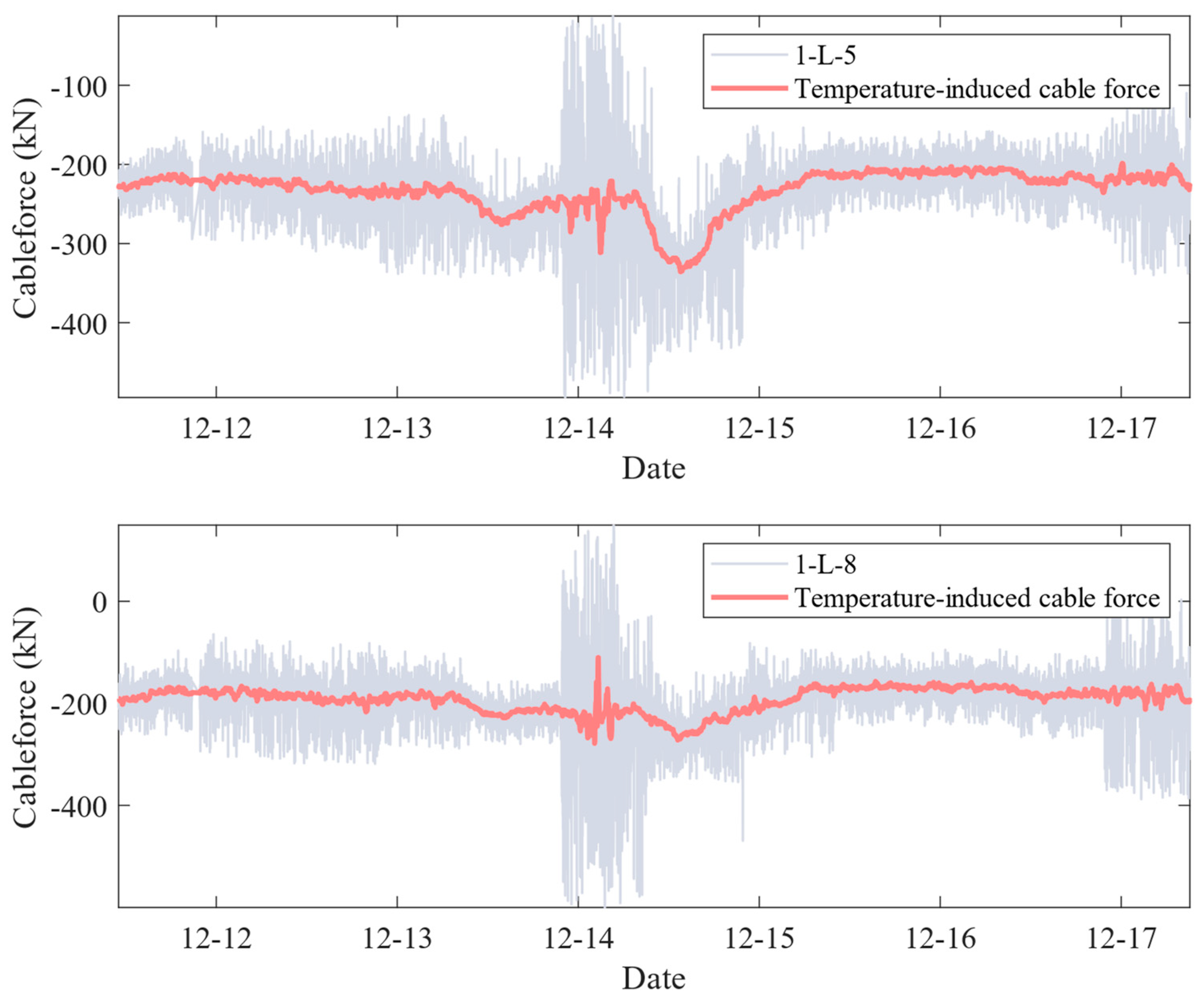
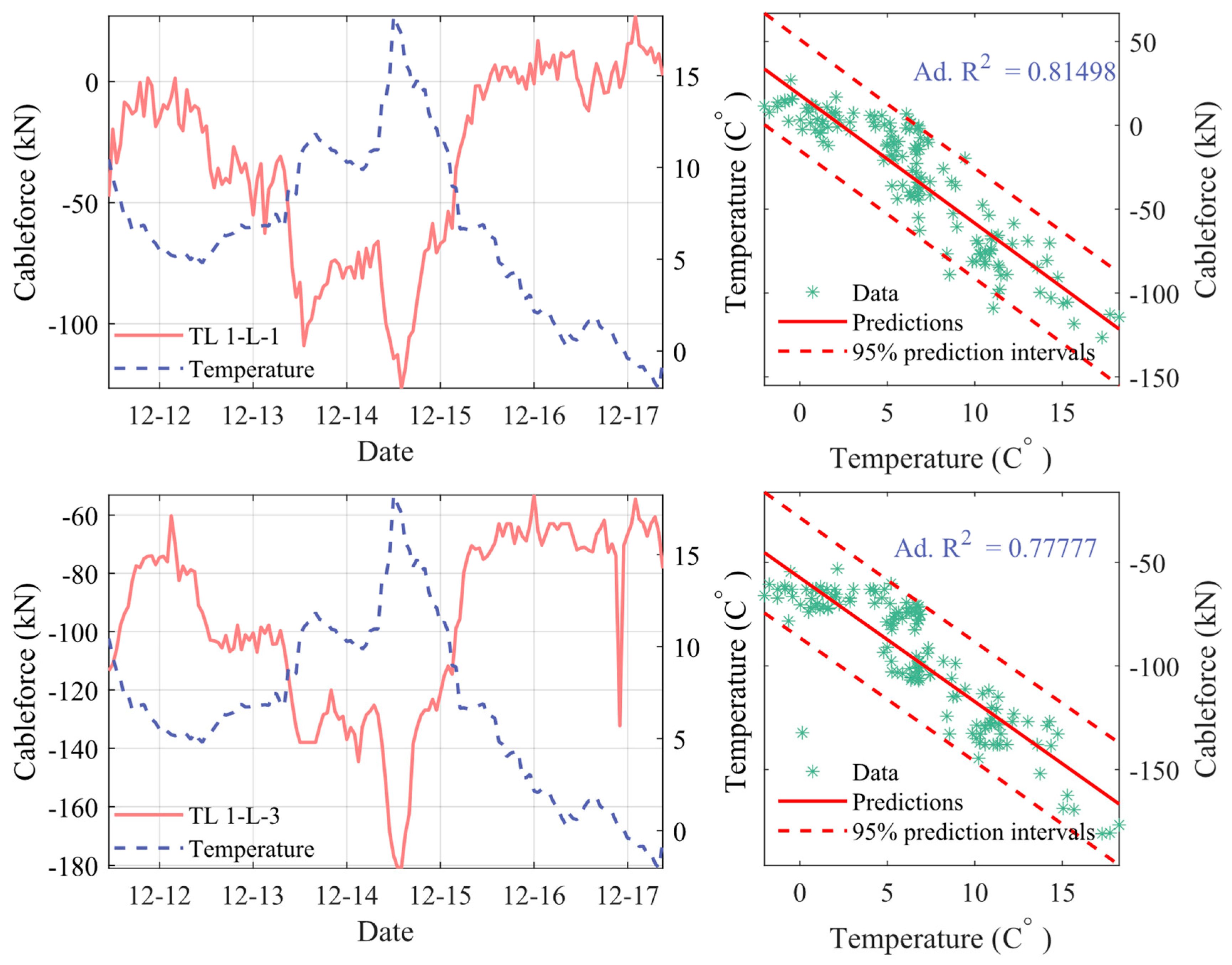
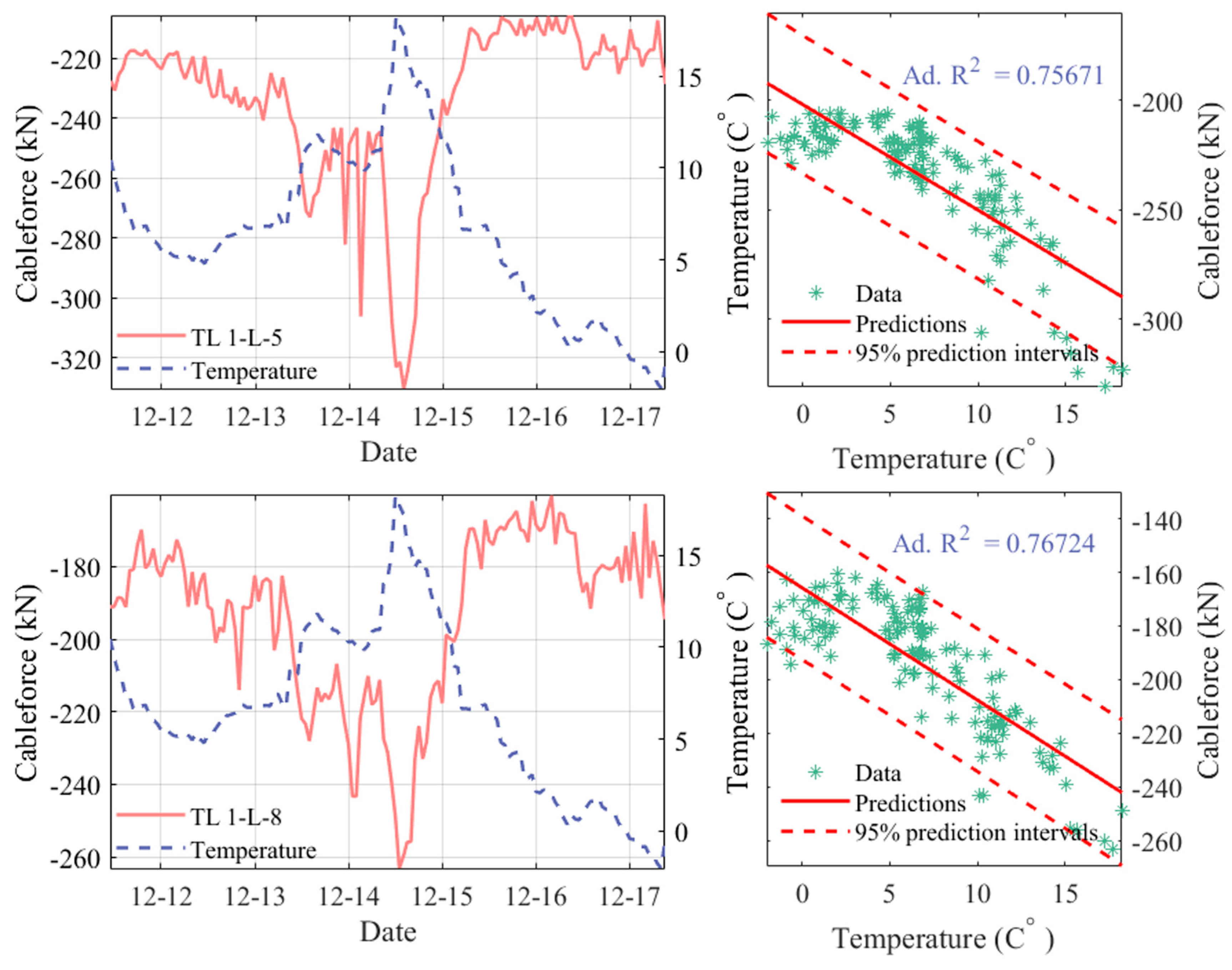
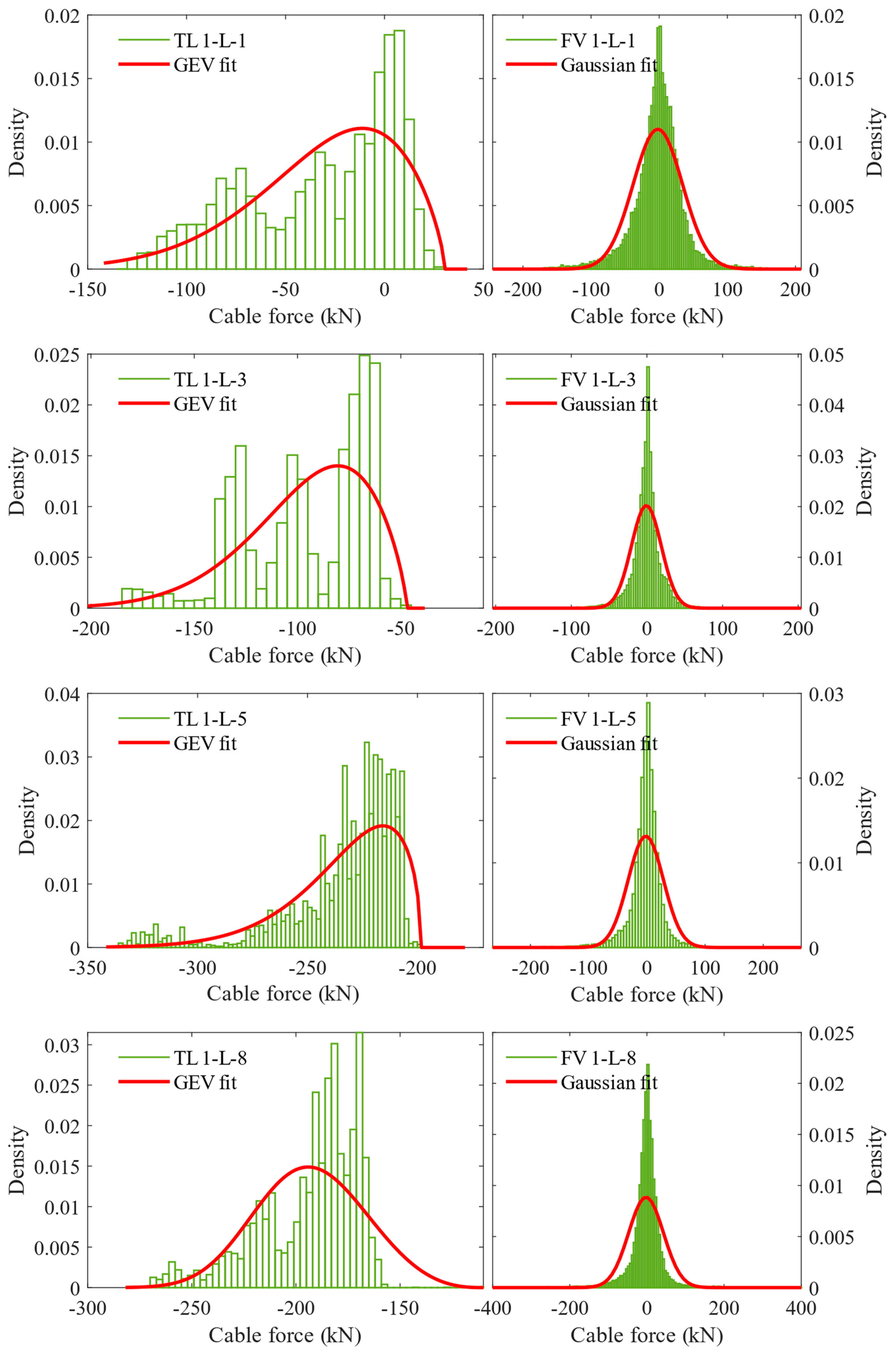
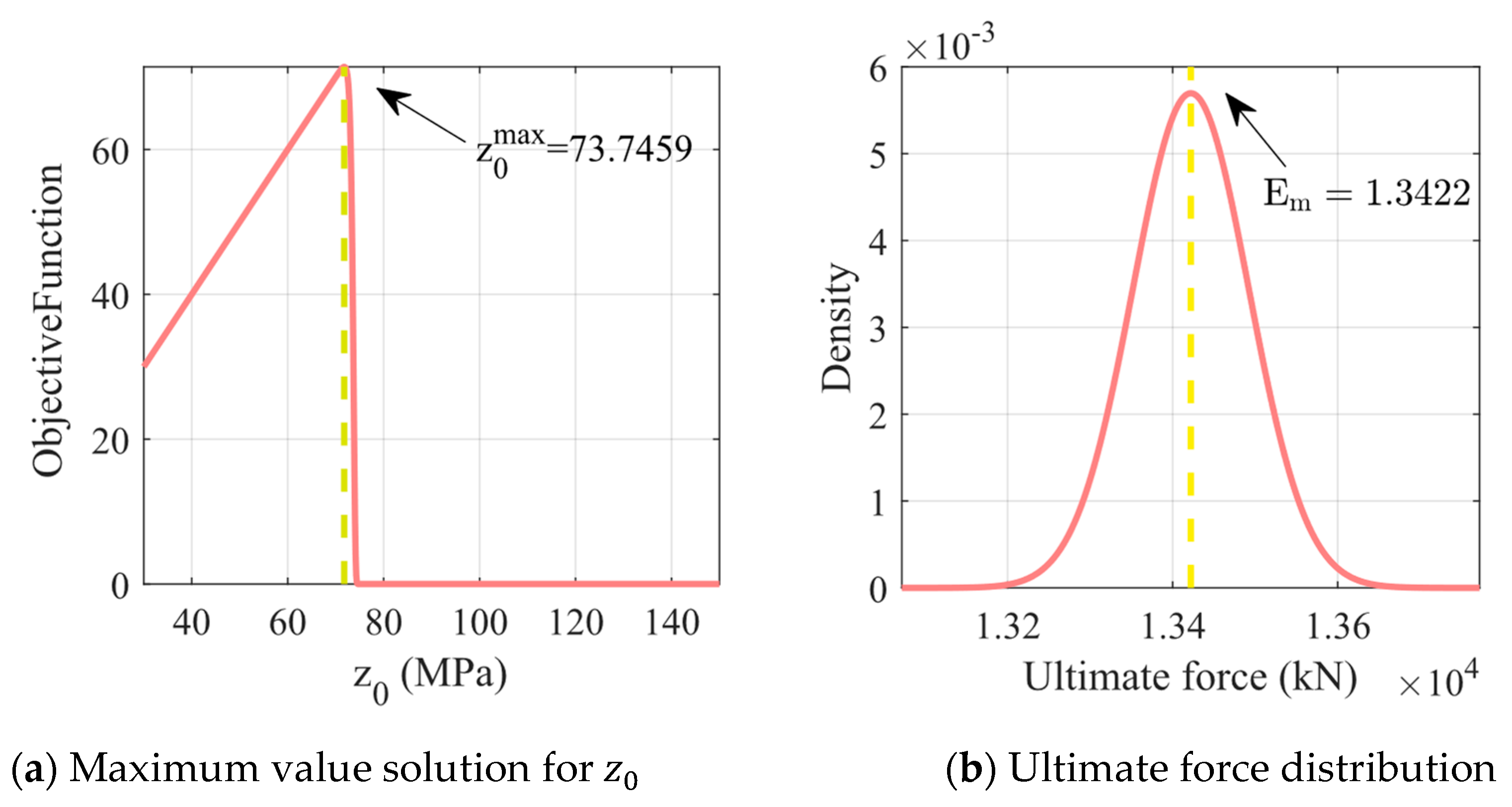

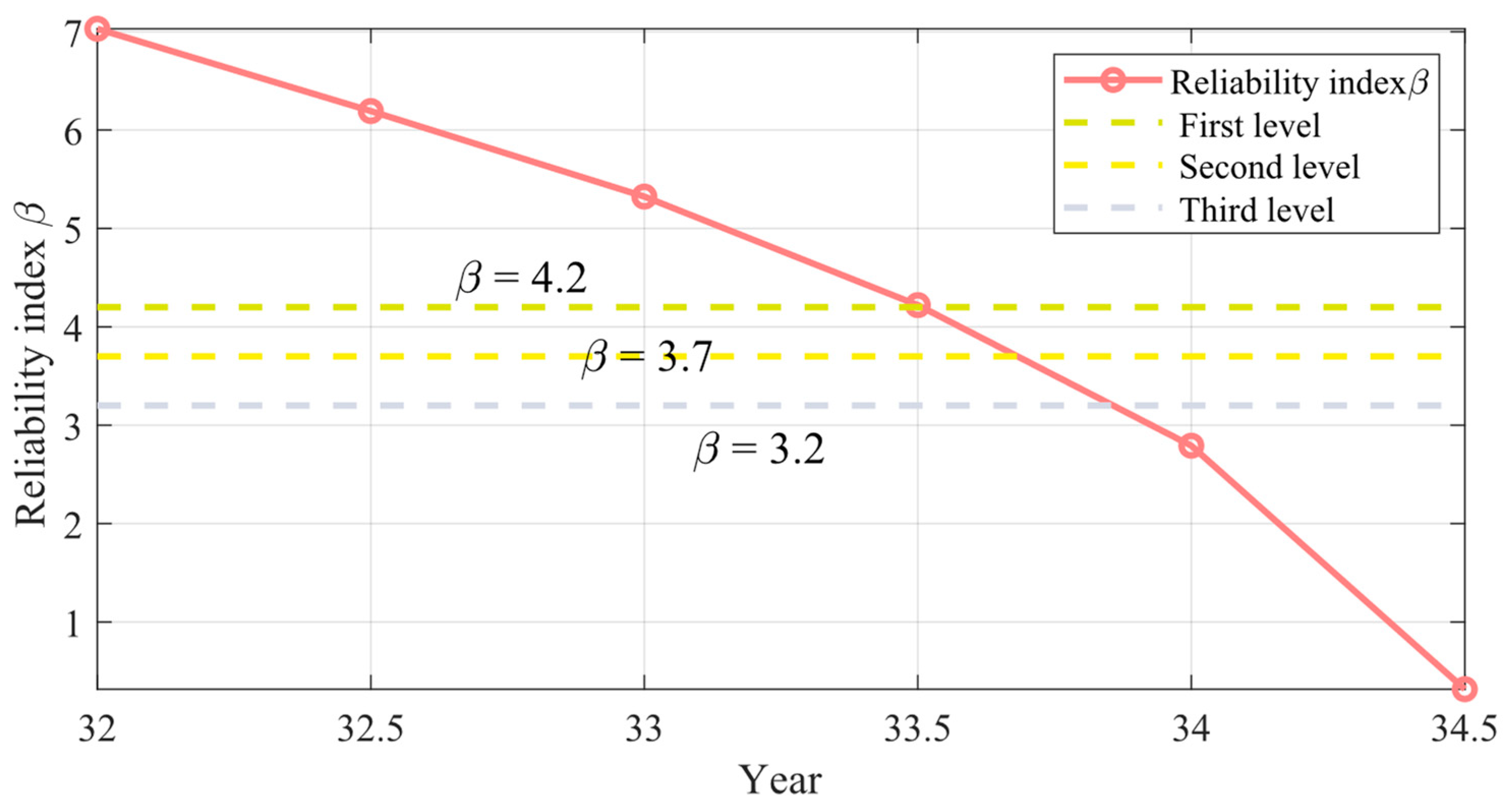
| No. | Type | Effective Length (m) | Mass Per Unit Length (kg/m) | Axial Stiffness (KN) |
|---|---|---|---|---|
| 1-L-1 | PESM 7-187 | 79.45 | 56.29 | 4979 |
| 1-L-2 | PESM 7-187 | 73.19 | 56.29 | 4897 |
| 1-L-3 | PESM 7-187 | 65.35 | 56.29 | 4875 |
| 1-L-4 | PESM 7-187 | 57.56 | 56.29 | 4809 |
| 1-L-5 | PESM 7-187 | 49.87 | 56.29 | 4749 |
| 1-L-6 | PESM 7-187 | 42.27 | 56.29 | 4705 |
| 1-L-7 | PESM 7-187 | 34.78 | 56.29 | 4621 |
| 1-L-8 | PESM 7-187 | 27.39 | 56.29 | 4579 |
| No. | Type | Distribution | Fitted Parameters |
|---|---|---|---|
| 1-L-1# | Slow trend | GEV (type III) | |
| Fast trend | GD | ||
| Dead load | Constant | 4750 | |
| 1-L-3# | Slow trend | GEV (type III) | |
| Fast trend | GD | ||
| Dead load | Constant | 4680 | |
| 1-L-5# | Slow trend | GEV (type III) | |
| Fast trend | GD | ||
| Dead load | Constant | 4530 | |
| 1-L-8# | Slow trend | GEV (type III) | |
| Fast trend | GD | ||
| Dead load | Constant | 4568 |
Disclaimer/Publisher’s Note: The statements, opinions and data contained in all publications are solely those of the individual author(s) and contributor(s) and not of MDPI and/or the editor(s). MDPI and/or the editor(s) disclaim responsibility for any injury to people or property resulting from any ideas, methods, instructions or products referred to in the content. |
© 2024 by the authors. Licensee MDPI, Basel, Switzerland. This article is an open access article distributed under the terms and conditions of the Creative Commons Attribution (CC BY) license (https://creativecommons.org/licenses/by/4.0/).
Share and Cite
Lu, H.-X.; Li, G.; Fu, W.; Chen, Y.; Li, B.; Ma, W. Unveiling Structural Secrets: Active Learning for Assessing Ultimate Load Capacity in Parallel Wire Cable Systems under Time-Varying Force Identification with Frequency-Squeezing Processing and Vibration Frequency Method. Buildings 2024, 14, 1807. https://doi.org/10.3390/buildings14061807
Lu H-X, Li G, Fu W, Chen Y, Li B, Ma W. Unveiling Structural Secrets: Active Learning for Assessing Ultimate Load Capacity in Parallel Wire Cable Systems under Time-Varying Force Identification with Frequency-Squeezing Processing and Vibration Frequency Method. Buildings. 2024; 14(6):1807. https://doi.org/10.3390/buildings14061807
Chicago/Turabian StyleLu, Hong-Xia, Gang Li, Wenwei Fu, Yi Chen, Bingchun Li, and Wenwen Ma. 2024. "Unveiling Structural Secrets: Active Learning for Assessing Ultimate Load Capacity in Parallel Wire Cable Systems under Time-Varying Force Identification with Frequency-Squeezing Processing and Vibration Frequency Method" Buildings 14, no. 6: 1807. https://doi.org/10.3390/buildings14061807





